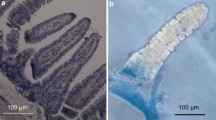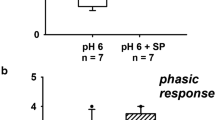Abstract
We have examined the mechanism whereby C-type natriuretic peptide (CNP), an agonist acting through the second messenger cGMP, enhances NaCl secretion in the rectal gland of Squalus acanthias. Single rectal gland tubules (RGT) were dissected manually, perfused in vitro and equivalent short-circuit current [I sc=transepithelial voltage/transepithelial resistance (R te)] as well as basolateral membrane voltage (V bl) were measured. CNP was added to luminal and basolateral perfusates at concentrations between 1 and 1000 nmol/l and its effects on the above parameters were compared to those of a ”stimulation cocktail” (Stim, containing dibutyryl cAMP, adenosine and forskolin) that maximally enhances cytosolic cAMP, and other agonists and hormones such as guanylin, vasoactive intestinal peptide (VIP), and adenosine. CNP had no effect from the luminal side (n=6). Its effects from the basolateral side consisted of a substantial increase in I sc (–31.6±7.7 to –316±82.2 µA/cm2, n=15). CNP significantly depolarized the luminal membrane from –87.4±1.0 to –82.3±2.6 mV (n=12). V bl was not changed (n=12) but the fractional conductance for K+ was increased (n=3). These effects were qualitatively and even quantitatively comparable to those of other agonists acting via cytosolic cAMP, but were less marked than those caused by Stim (n=64). The effects of VIP and CNP on I sc were not additive (n=5). The cytosolic Ca2+ concentration ([Ca2+]i) was monitored using the fura-2 fluorescence ratio (FFR 340/380 nm) and it was found that CNP, like agonists acting via cAMP, enhances FFR significantly from 1.02±0.05 to 1.32±0.05 (n=8) with a time constant in the 1–2 min in range. Our data suggest that CNP, acting via the second messenger cGMP, induces a marked increase in I sc in the rectal gland. The concomitant fall in R te corresponds to increases in the luminal membrane Cl– conductance and in the basolateral membrane K+ conductance. The latter effect is probably due to an increase in [Ca2+]i.
Similar content being viewed by others
Author information
Authors and Affiliations
Additional information
Received: 21 December 1998 / Received after revision: 5 February 1999 / Accepted: 9 February 1999
Rights and permissions
About this article
Cite this article
Greger, R., Bleich, M., Warth, R. et al. The cellular mechanisms of Cl– secretion induced by C-type natriuretic peptide (CNP). Experiments on isolated in vitro perfused rectal gland tubules of Squalus acanthias . Pflügers Arch 438, 15–22 (1999). https://doi.org/10.1007/s004240050874
Issue Date:
DOI: https://doi.org/10.1007/s004240050874




